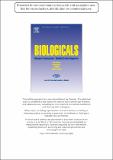Buscar
Mostrando ítems 21-30 de 56
Pharmacokinetic-pharmacodynamic relationships of immunoglobulin therapy for envenomation.
(2003-07)
Parenteral administration of horse- and sheep-derived antivenoms constitutes the cornerstone in the therapy of envenomations induced by animal bites and stings. Depending on the type of neutralising molecule, antivenoms ...
Antivenoms for Snakebite Envenomings
(2011-10)
Animal-derived antivenoms constitute the mainstay in the therapy of snakebite envenoming. Antivenoms are manufactured by immunizing animals, usually horses, with venoms from a single or several medically-relevant snake ...
Impact of Regional Variation in Bothrops asper Snake Venom on the Design of Antivenoms: Integrating Antivenomics and Neutralization Approaches
(2010-10-21)
Intraspecific snake venom variations have implications in the preparation of venom pools for the generation of antivenoms. The impact of such variation in the cross-reactivity of antivenoms against Bothrops asper venom was ...
Snake Venomics of African Spitting Cobras: Toxin Composition and Assessment of Congeneric Cross-Reactivity of the Pan-African EchiTAb-Plus-ICP Antivenom by Antivenomics and Neutralization Approaches
(2011)
Venomic analysis of the venoms of Naja nigricollis, N. katiensis, N. nubiae, N. mossambica, and N. pallida revealed similar compositional trends. The high content of cytotoxins and PLA2s may account for the extensive tissue ...
Immunoglobulin G and F(ab')2 polyvalent antivenoms do not differ in their ability to neutralize hemorrhage, edema and myonecrosis induced by Bothrops asper (terciopelo) snake venom
(1997-11)
The ability of whole immunoglobulin G (IgG) and F(ab')2 polyvalent (Crotalinae) antivenoms to neutralize the hemorrhagic, edema-forming and myotoxic activities of Bothrops asper venom was studied. Both antivenoms were ...
Assessing the preclinical efficacy of antivenoms: From the lethality neutralization assay to antivenomics
(2013-07)
The assessment of the capacity of antivenoms to neutralize the lethal activity of snake
venoms is the gold standard in the preclinical analysis of antivenom efficacy, and is
routinely performed by manufacturers and quality ...
Anti-human erythrocyte antibodies in horse-derived antivenoms used in the treatment of snakebite envenomations
(2007-03)
This work examined the presence of antibodies reacting with human erythrocytes in horse-derived antivenoms used in the treatment of snakebite envenomations, and assessed the efficacy of various fractionation protocols in ...
Effect of Preservatives on IgG Aggregation, Complement-activating Effect and Hypotensive Activity of Horse Polyvalent Antivenom Used in Snakebite Envenomation
(2002-06)
Intravenous administration of antivenoms is associated with early adverse reactions in a number of cases, but the causes of this phenomenon are still unclear. The effect of preservatives (phenol and thimerosal) on IgG ...
Preclinical assessment of the efficacy of a new antivenom (EchiTAb-Plus-ICP) for the treatment of viper envenoming in sub-Saharan Africa
(2010-02)
A preclinical assessment was performed on the neutralizing efficacy of a whole IgG polyspecific antivenom (EchiTAb-Plus-ICP®), designed for the treatment of snakebite envenomings in Nigeria. It was generated by immunizing ...
Intravenous administration of equine-derived whole IgG antivenom does not induce early adverse reactions in non-envenomed horses and cows
(2010-11)
Administration of antivenoms to treat snakebite envenomings has the potential risk of inducing early adverse reactions. The mechanisms involved in these reactions are unclear. In this study, polyspecific antivenom consisting ...



